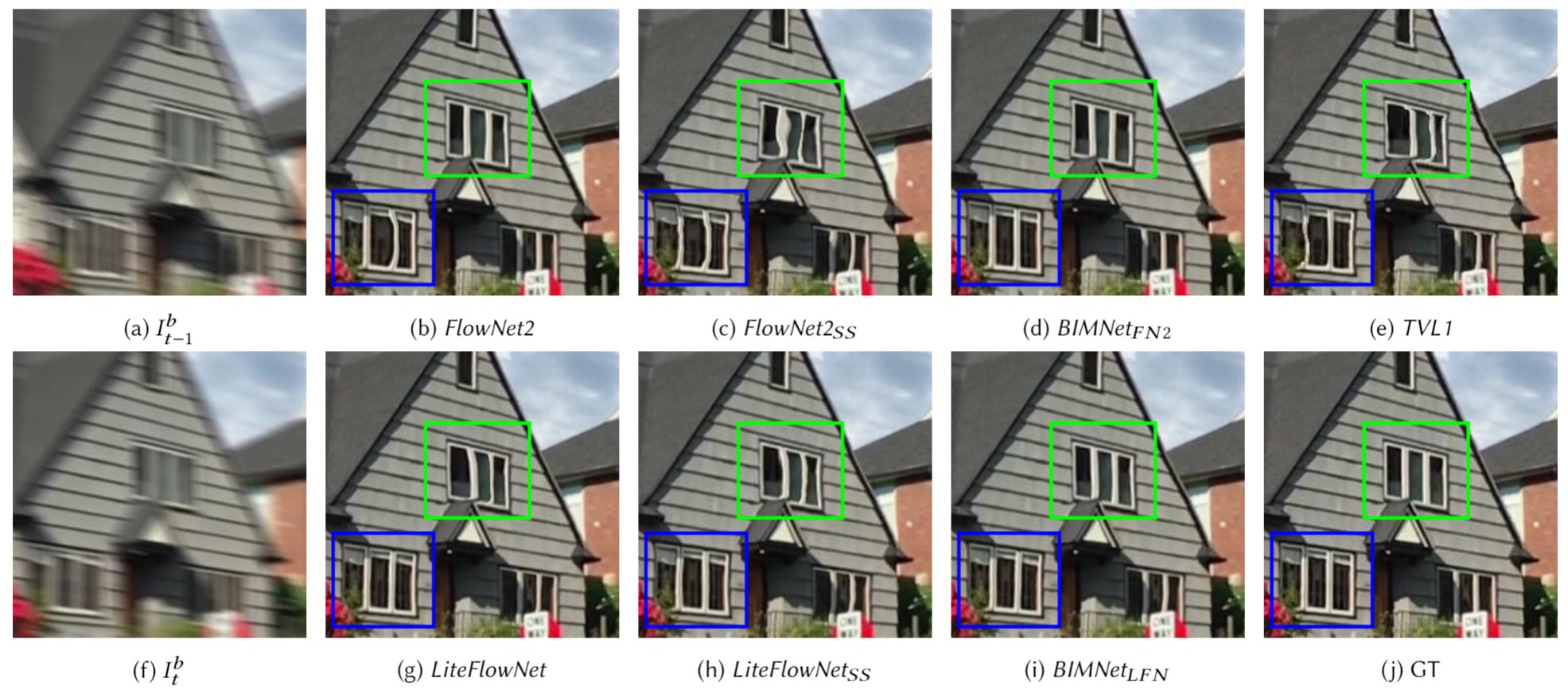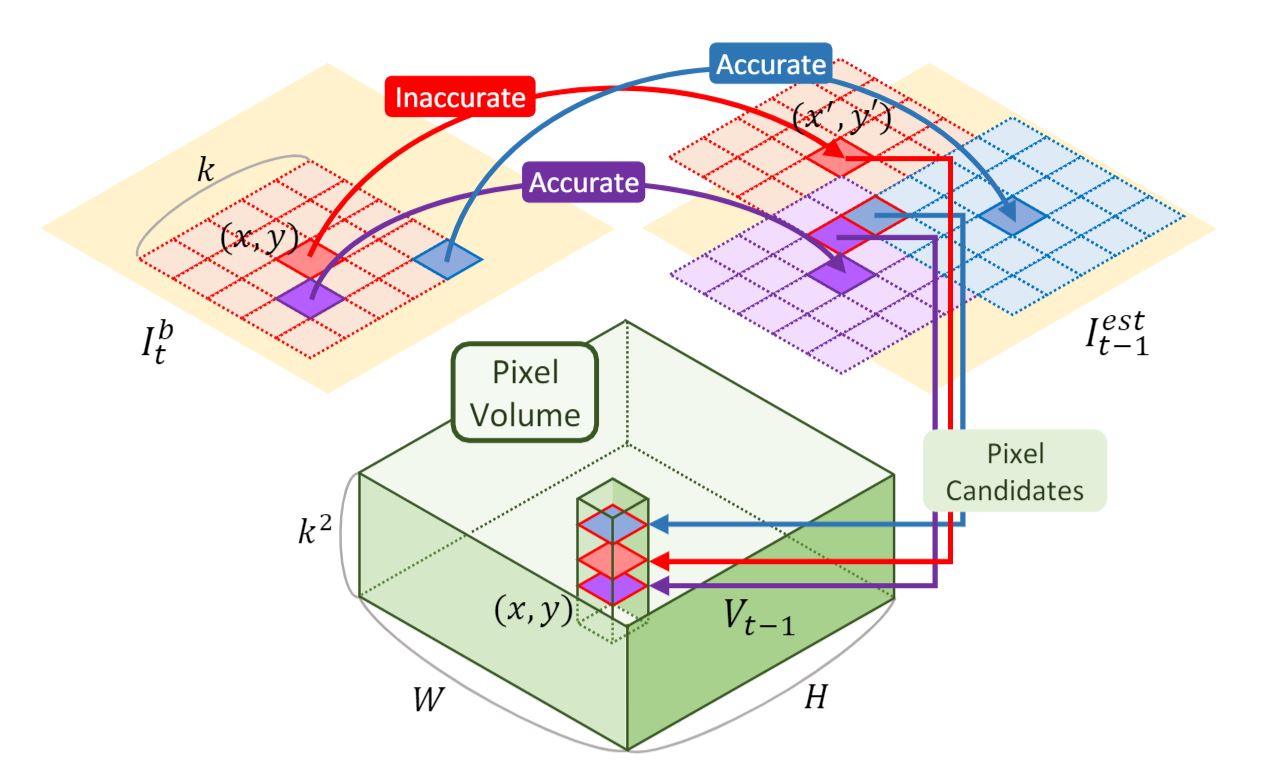This repository contains the official PyTorch implementation of the following paper:
Recurrent Video Deblurring with Blur-Invariant Motion Estimation and Pixel Volumes
Hyeongseok Son, Junyong Lee, Jonghyeop Lee, Sunghyun Cho, Seungyong Lee, TOG 2021 (presented at SIGGRAPH 2021)
Click here
Our video deblurring framework consists of three modules: a blur-invariant motion estimation network (BIMNet), a pixel volume generator, and a pixel volume-based deblurring network (PVDNet). We first train BIMNet; after it has converged, we combine the two networks with the pixel volume generator. We then fix the parameters of BIMNet and train PVDNet by training the entire network.
To estimate motion between frames accurately, we adopt LiteFlowNet and train it with a blur-invariant loss so that the trained network can estimate blur-invariant optical flow between frames.
We train BIMNet with a blur-invariant loss , which is defined as (refer Eq. 1 in the main paper):
The figure shows a qualitative comparison of different optical flow methods. The results of the other methods contain severely distorted structures due to errors in their optical flow maps. In contrast, the results of BIMNets show much less distortions.
We propose a novel pixel volume that provides multiple candidates for matching pixels between images. Moreover, a pixel volume provides an additional cue for motion compensation based on the majority.
Our pixel volume approach leads to the performance improvement of video deblurring by utilizing the multiple candidates in a pixel volume in two aspects: 1) in most cases, the majority cue for the correct match would help as the statistics (Sec. 4.4 in the main paper) shows, and 2) in other cases, PVDNet would exploit multiple candidates to estimate the correct match referring to nearby pixels with majority cues.
Tested environment
-
Environment setup
$ git clone https://github.com/codeslake/PVDNet.git $ cd PVDNet $ conda create -y --name PVDNet python=3.8 && conda activate PVDNet # for CUDA10.2 $ sh install_CUDA10.2.sh # for CUDA11.1 $ sh install_CUDA11.1.sh
-
Datasets
-
Download and unzip Su et al.'s dataset and Nah et al.'s dataset under
[DATASET_ROOT]:├── [DATASET_ROOT] │ ├── train_DVD │ ├── test_DVD │ ├── train_nah │ ├── test_nahNote:
[DATASET_ROOT]is currently set to./datasets/video_deblur. It can be specified by modifyingconfig.data_offsetin./configs/config.py.
-
-
Pre-trained models
-
Download and unzip pretrained weights under
./ckpt/:├── ./ckpt │ ├── BIMNet.pytorch │ ├── PVDNet_DVD.pytorch │ ├── PVDNet_nah.pytorch │ ├── PVDNet_large_nah.pytorch
-
For PSNRs and SSIMs reported in the paper, we use the approach of Koehler et al.
following Su et al.,
that first aligns two images using global translation to represent the ambiguity in the pixel location caused by blur.
Refer here for the evaluation code.
## Table 4 in the main paper (Evaluation on Su etal's dataset)
# Our final model
CUDA_VISIBLE_DEVICES=0 python run.py --mode PVDNet_DVD --config config_PVDNet --data DVD --ckpt_abs_name ckpt/PVDNet_DVD.pytorch
## Table 5 in the main paper (Evaluation on Nah etal's dataset)
# Our final model
CUDA_VISIBLE_DEVICES=0 python run.py --mode PVDNet_nah --config config_PVDNet --data nah --ckpt_abs_name ckpt/PVDNet_nah.pytorch
# Larger model
CUDA_VISIBLE_DEVICES=0 python run.py --mode PVDNet_large_nah --config config_PVDNet_large --data nah --ckpt_abs_name ckpt/PVDNet_large_nah.pytorchNote:
- Testing results will be saved in
[LOG_ROOT]/PVDNet_TOG2021/[mode]/result/quanti_quali/[mode]_[epoch]/[data]/.[LOG_ROOT]is set to./logs/by default. Refer here for more details about the logging.
- options
--data: The name of a dataset to evaluate:DVD|nah|random. Default:DVD- The data structure can be modified in the function
set_eval_path(..)in./configs/config.py. randomis for testing models with any video frames, which should be placed as[DATASET_ROOT]/random/[video_name]/*.[jpg|png].
- The data structure can be modified in the function
If you find this code useful, please consider citing:
@artical{Son_2021_TOG,
author = {Son, Hyeongseok and Lee, Junyong and Lee, Jonghyeop and Cho, Sunghyun and Lee, Seungyong},
title = {Recurrent Video Deblurring with Blur-Invariant Motion Estimation and Pixel Volumes},
journal = {ACM Transactions on Graphics},
year = {2021}
}
Open an issue for any inquiries. You may also have contact with sonhs@postech.ac.kr or junyonglee@postech.ac.kr
All material related to our paper is available by following links:
| Link |
|---|
| The main paper |
| arXiv |
| Supplementary Files |
| Checkpoint Files |
| Su et al [2017]'s dataset (reference) |
| Nah et al. [2017]'s dataset (reference) |
This software is being made available under the terms in the LICENSE file.
Any exemptions to these terms require a license from the Pohang University of Science and Technology.
Project ‘COUPE’ aims to develop software that evaluates and improves the quality of images and videos based on big visual data. To achieve the goal, we extract sharpness, color, composition features from images and develop technologies for restoring and improving by using them. In addition, personalization technology through user reference analysis is under study.
Please check out other Coupe repositories in our Posgraph github organization.









